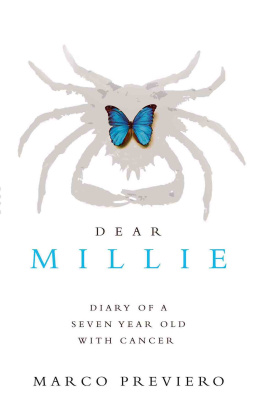MISSING MILLIE BENSON

The Secret Case of the Nancy Drew Ghostwriter and Journalist
MISSING MILLIE BENSON
By
Julie K. Rubini
BIOGRAPHIES FOR YOUNG READERS
Ohio University Press
Athens
Ohio University Press, Athens, Ohio 45701
ohioswallow.com
2015 by Ohio University Press
All rights reserved
To obtain permission to quote, reprint, or otherwise reproduce or distribute material from Ohio University Press publications, please contact our rights and permissions department at (740) 593-1154 or (740) 593-4536 (fax)
Printed in the United States of America
Ohio University Press books are printed on acid-free paper 
24 23 22 21 20 19 18 17 16 15 5 4 3 2 1
: Mildred A. Wirt. From the private collection of the Mildred Augustine Wirt Benson family.
Library of Congress Cataloging-in-Publication Data
available upon request.
Contents
Authors Note
THE BOOKCASE is long gone. So too are the books that used to sit on its shelves. Their disappearance is a mystery to me. The yellow bindings beckoned me with their intriguing titles: The Secret of the Old Clock, The Hidden Staircase, The Bungalow Mystery.
My collection was not large. I was raised in a family with six children, and my fathers was the only income. A purchased book was a rare gift. The bookmobile that arrived weekly near my home provided the solution in my quest to read about Nancy Drews latest adventures.
I would pedal my banana-seat bike over the hot tar-covered road, with the basket carrying what I had read the week prior. I couldnt get to the library on wheels fast enough. Id scan the shelves from floor to ceiling, hoping for a new work by Carolyn Keene. If I was lucky, Id walk away with another volume of the mystery series in hand.
My sister and I would smuggle home-baked cookies into our room during mandatory quiet time in the afternoon. The summer breeze from the box elder tree just outside the window offered a break from the heat. Wed settle in, with our books spread across our beds, and our sun-kissed faces tucked into the pages filled with action and adventure.
I loved Nancys ability to overcome any challenge independently and admired her ability to come and go as she pleased. Nancy reported only to her father and had a housekeeper to look after her. I envied her. I wanted to be her.
Nancy Drew created a reader out of me. Or should I say Mildred Millie Benson, the original writer of the Nancy Drew series, did?
As a young mother, I shared my love of reading with my children, daughters Claire and Kyle, and their younger brother Ian.
When Claire died at just ten years of age, my family, including my husband, Brad, established an organization that stages a childrens book festival in her honor. Claires Day features childrens book authors and illustrators from near and far who share their passions with the thousands of families that join us every year.
The very first Claires Day was held on May 18, 2002, in my town of Maumee, Ohio. I invited Millie, who had lived in neighboring Toledo for many years, to join us as a special guest for the day. I missed her reply phone call. Her sweet, feeble voice on my answering machine, offering her condolences, her admiration for our tribute, and her regrets in not being able to attend due to her failing health, remained with me. She died ten days later.
I did not realize that the Nancy Drew mystery stories that I grew up on were not Millies original works. They were versions revised in 1959.
However, Millie was the original writer of the series. All of the many characterizations of Nancy that followed stemmed from the independent, feisty sleuth molded by Millie.
As I have lived all my life in northwest Ohio, I have known for some time of Millies instrumental role with the Nancy Drew Mystery Stories. I also knew of her many years as a journalist, and enjoyed reading her various features and columns.
But there was so much of Millies life that was a mystery to me before I was given this opportunity to research and relay her life story. Her life was filled with adventure and challenges fueled by her indomitable spirit. I came to realize that the person who should be admired for her fierce independence, spirit, and spunk is not Nancy Drew.
Its Millie.
MISSING MILLIE BENSON
THE FIRST CLUE
GHOSTWRITER REAPPEARS
The Case of the Missing Ghostwriter
FOR THE first fifty years of the series, readers of the Nancy Drew Mystery Stories, whether of the originals with the dusty blue cloth covers or the newer books with the bright yellow spines, knew that all those mysteries were written by Carolyn Keene. But who was she? No one had ever met this talented writer, seen a photograph of her face, or heard her voice on the radio. How could one of the most famous and beloved authors of suspenseful books for young people be such a mysterious figure herself?
This is where the plot thickens.
There is no Carolyn Keene. There never was.
BUT, like the adventurous girl detective Nancy Drew, the original writer of the series was always ready to take her readers on an exciting ride. And on May 27, 1980, she did just thatup the steps and into a courtroom of the United States District Court in Manhattan, and into the pages of a real life mystery to be solved as a result of a court trial.

THE FIRST BOOK IN THE NANCY DREW MYSTERY STORIES, THE SECRET OF THE OLD CLOCK, 1930
The Secret of the Old Clock, Carolyn Keene, Grosset & Dunlap. Permission granted by Penguin Group (USA) LLC.
It was a complicated trial. It involved two publishers, the businesses that print books and make them available to readers.
Both companies were fighting over the rights to publish future Nancy Drew Mystery Stories. At the end of this trial, one of the companies would win those rights; the other company would lose.
One publisher, Grosset & Dunlap, was trying to convince the judge that it should be allowed to publish new Nancy Drew Mystery Stories. That company had been making Nancy Drews adventures available to readers since their beginning in 1930, but it had recently lost the right to publish new ones.
The other publisher, Simon & Schuster, had been chosen by the Stratemeyer Syndicate, the creator of the series, to publish those new Nancy Drew books. Simon & Schuster wanted the judge to decide that its company should retain the right to do so.
The Stratemeyer Syndicate was a book packaging business. The company matched writers up with books it was creating. Just as a newspaper assigns stories to writers, the Syndicate did with books. Once a writer had finished a story, the Syndicate would send the completed manuscript to a publisher. The publisher then printed the books and sold them to readers.
The Stratemeyer Syndicate and the publisher Grosset & Dunlap had been working together for almost seventy years. Then the two had parted ways over an issue they did not agree on. Grosset & Dunlap paid an amount of money, a royalty, to the Syndicate for every book purchased that the Syndicate had created. This meant for every Nancy Drew book that a young reader bought Grosset & Dunlap paid money to the Stratemeyer Syndicate.
Because the Nancy Drew books had always been popular, when their sales started to decline, the Syndicate blamed the publisher. Grosset & Dunlap, it felt, was not doing a good job promoting the books. So the Syndicate signed a contract with another publisher, Simon & Schuster.
Next page










